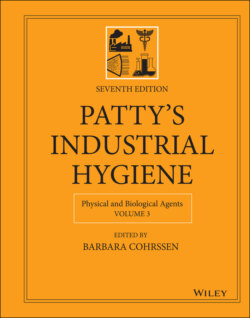Читать книгу Patty's Industrial Hygiene, Physical and Biological Agents - Группа авторов - Страница 63
12.3 Air Sampling
ОглавлениеAir sampling in a radioactive environment is essentially the same as sampling in the ordinary industrial environment. The air sampling systems used in the two environments are exactly the same. First, an appropriate collecting device, chosen based on the nature of the contaminant, is used, such as a filter, a liquid absorber, or a charcoal‐adsorbing medium. Then, a metering device for measuring the volume of air sampled, and finally a pump for sucking the air through the collector is used. Although the overall sampling strategy is the same for both nonradioactive and radioactive environments, there are some differences in the details. The size of the sample is determined by the analytical capabilities of the laboratory. In the case of radioactivity, the half‐life of the contaminant may influence the sample size. If the half‐life is very short, the collected activity will decay while the sample is still being collected, and may reach a steady state where the quantity of activity that decays is equal to the quantity collected. Under these conditions, increasing the sampling time does not increase the sample size. If this steady‐state activity is less than the lower limit of detection by the analytical procedure, then the volumetric sampling rate (not the sampling time) must be increased.
Another air sampling detail deals with the actual quantity of the contaminant. For example, OSHA's PEL for airborne lead is 0.05 mg m−3. For 1 μm mass median aerodynamic diameter (MMAD) particles, the PEL corresponds to 3.13 × 108 particles m−3. NRC's DAC for lead‐210 is 1 × 10−4 μCi m−3, which corresponds to a 1‐μm‐sized particle concentration of 8 particles m−3. If the 210Pb were uniformly dispersed throughout the air, and if one wished to determine 50% of the DAC, that is, 5 × 10−5 μCi m−3, and if the lower limit of detection of the counting system is 5 × 10−6 μCi, the required sample volume would be calculated as
However, because the radioactive lead is not continuously dispersed throughout the air, but is randomly distributed as a very small number of discrete particles, we must consider the probability of catching a particle in our sample. If one wishes to detect 50% of a DAC, or 4 particles m−3 within ±25% at the 95% CI (confidence interval), the required sample size is 16 m3, calculated as follows:
According to Poisson statistics
